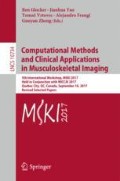Abstract
Three-dimensional (3D) muscle fiber architecture is important in patient-specific biomechanical simulation. While several in-vivo methods using diffusion tensor imaging and ultrasound have been demonstrated their feasibility in reconstruction of the fiber architecture, the main challenge is the lack of gold standard. Although physical measurement from cadavers has been considered as the accurate way of determining 3D muscle fiber architecture, its downsides include error in the manual tracing and the labor intensive process allowing only sparse sampling of a particular muscle. We propose an alternative method of obtaining a dense fiber architecture of multiple muscles in close proximity using high resolution cryosectioned images. Similar to the diffusion tensor imaging, we first extract the local orientation at each voxel using the structure tensor analysis and then tractography algorithm is applied to obtain stream lines. The proposed method was applied to all muscles around the hip joint and the masticatory muscles. Qualitative comparison with the anatomy textbook indicated that the proposed method reconstructed a plausible muscle fiber architecture. We plan to make the reconstructed fiber architecture of whole body muscles publicly available in order to serve for the biomechanics community.
Access this chapter
Tax calculation will be finalised at checkout
Purchases are for personal use only
Notes
References
Rajagopal, A., Dembia, C., DeMers, M., Delp, D., Hicks, J., Delp, S.: Full-body musculoskeletal model for muscle-driven simulation of human gait. IEEE Trans. Biomed. Eng. 63(10), 2068–2079 (2016)
Marra, M., Vanheule, V., Fluit, R., Koopman, B., Rasmussen, J., Verdonschot, N., Andersen, M.: A subject-specific musculoskeletal modeling framework to predict in vivo mechanics of total knee arthroplasty. J. Biomech. Eng. 137(2), 020904 (2015)
Webb, J., Blemker, S., Delp, S.: 3D finite element models of shoulder muscles for computing lines of actions and moment arms. Comput. Methods Biomech. Biomed. Engin. 17(8), 829–837 (2014)
Hicks, J., Uchida, T., Seth, A., Rajagopal, A., Delp, S.: Is my model good enough? Best practices for verification and validation of musculoskeletal models and simulations of movement. J. Biomech. Eng. 137(2), 020905 (2015)
Blemker, S., Delp, S.: Three-dimensional representation of complex muscle architectures and geometries. Ann. Biomed. Eng. 33(5), 661–673 (2005)
Damon, B., Froeling, M., Buck, A., Oudeman, J., Ding, Z., Nederveen, A., Bush, E., Strijkers, G.: Skeletal muscle diffusion tensor-MRI fiber tracking: rationale, data acquisition and analysis methods, applications and future directions. NMR Biomed. 30(3), e3563 (2017)
Bolsterlee, B., Veeger, H., van der Helm, F., Gandevia, S., Herbert, R.: Comparison of measurements of medial gastrocnemius architectural parameters from ultrasound and diffusion tensor images. J. Biomech. 48(6), 1133–1140 (2015)
Schenk, P., Siebert, T., Hiepe, P., Güllmar, D., Reichenbach, J., Wick, C., Blickhan, R., Böl, M.: Determination of three-dimensional muscle architectures: validation of the DTI-based fiber tractography method by manual digitization. J. Anat. 223(1), 61–68 (2013)
Engelina, S., Robertson, C., Moggridge, J., Killingback, A., Adds, P.: Using ultrasound to measure the fibre angle of vastus medialis oblique: a cadaveric validation study. Knee 21(1), 107–111 (2014)
Wang, H., Lenglet, C., Akkin, T.: Structure tensor analysis of serial optical coherence scanner images for mapping fiber orientations and tractography in the brain. J. Biomed. Opt. 20(3), 036003 (2015)
Park, J., Chung, M., Hwang, S., Lee, Y., Har, D., Park, H.: Visible Korean human: improved serially sectioned images of the entire body. IEEE Trans. Med. Imaging 24(3), 352–360 (2005)
Shin, D., Jang, H., Hwang, S., Har, D., Moon, Y., Chung, M.: Two-dimensional sectioned images and three-dimensional surface models for learning the anatomy of the female pelvis. Anat. Sci. Educ. 6(5), 316–323 (2013)
Bigun, J.: Optimal orientation detection of linear symmetry. In: Proceedings of the 1st IEEE International Conference on Computer Vision - ICCV 1987, pp. 433–438. IEEE (1987)
Westin, C., Maier, S., Mamata, H., Nabavi, A., Jolesz, F., Kikinis, R.: Processing and visualization for diffusion tensor MRI. Med. Image Anal. 6(2), 93–108 (2002)
Fedorov, A., Beichel, R., Kalpathy-Cramer, J., Finet, J., Fillion-Robin, J., Pujol, S., Bauer, C., Jennings, D., Fennessy, F., Sonka, M., Buatti, J., Aylward, S., Miller, J., Pieper, S., Kikinis, R.: 3D Slicer as an image computing platform for the Quantitative Imaging Network. Magn. Resonan. Imaging 30(9), 1323–1341 (2012)
Netter, F.: Atlas of Human Anatomy. Netter Basic Science, Elsevier Health Sciences (2010)
O’Donnell, L., Westin, C.F.: Automatic tractography segmentationu using a high-dimensional white matter atlas. IEEE Trans. Med. Imaging 26(11), 1562–1575 (2007)
Park, H., Choi, D., Park, J.: Improved sectioned images and surface models of the whole female body. Int. J. Morphol. 33(4), 1323–1332 (2015)
Yokota, F., Takaya, M., Okada, T., Sugano, N., Tada, Y., Tomiyama, N., Sato, Y.: Automated muscle segmentation from 3D CT data of the hip using hierarchical multi-atlas method. In: Proceedings of the 12th Annual Meeting of the International Society for Computer Assisted Orthopaedic Surgery - CAOS 2012 (2012)
Acknowledgements
This research was supported by MEXT/JSPS KAKENHI 26108004, JST PRESTO 20407, and AMED/ETH the strategic Japanese-Swiss cooperative research program, NIH grant U01CA199459 and P41EB015902.
Author information
Authors and Affiliations
Corresponding author
Editor information
Editors and Affiliations
Rights and permissions
Copyright information
© 2018 Springer International Publishing AG
About this paper
Cite this paper
Otake, Y. et al. (2018). Reconstruction of 3D Muscle Fiber Structure Using High Resolution Cryosectioned Volume. In: Glocker, B., Yao, J., Vrtovec, T., Frangi, A., Zheng, G. (eds) Computational Methods and Clinical Applications in Musculoskeletal Imaging. MSKI 2017. Lecture Notes in Computer Science(), vol 10734. Springer, Cham. https://doi.org/10.1007/978-3-319-74113-0_8
Download citation
DOI: https://doi.org/10.1007/978-3-319-74113-0_8
Published:
Publisher Name: Springer, Cham
Print ISBN: 978-3-319-74112-3
Online ISBN: 978-3-319-74113-0
eBook Packages: Computer ScienceComputer Science (R0)

